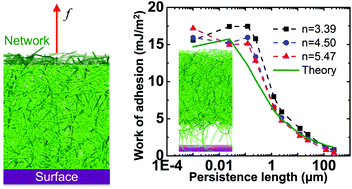Cohesive and adhesive properties of crosslinked semiflexible biopolymer networks†
Abstract
Biomolecular semiflexible polymer networks with persistence lengths well above those of single polymeric chains serve important structural and adhesive roles in biology, biomaterials, food science and many other fields. While relationships between the structure and viscoelasticity of semiflexible polymer networks have been previously investigated, it remains challenging to systematically relate fibril and network properties to cohesive and adhesive properties that govern the function of these materials. To address this issue, here we utilize coarse-grained molecular dynamics simulations to thoroughly elucidate how the work of adhesion of a semiflexible polymer network to a surface depends on crosslink density and fibril persistence length. Two emergent characteristics of the network are its elasticity and its interfacial energy with the surface. Stiff networks that are either highly crosslinked or have high persistence length fibrils tend to have lower interfacial energy, and consequently, lower work of adhesion. For lightly crosslinked networks with flexible fibrils, considerable strain energy must be stored within the adhesive during detachment, which creates an additional penalty to detachment. Increasing persistence length while keeping crosslink density constant leads to porous, low density networks, leading to an optimal fibril persistence length at which maximum work of adhesion per mass density is attained for a given crosslink density. For any given fibril persistence length, increasing crosslink density has a slightly negative effect on network mass density and interfacial energy. A critical crosslink density is found, below which the networks have no significant load-bearing capacity. Lightly crosslinked networks above this threshold absorb more strain energy during desorption and consequently possess greater work of adhesion. The conflict between mass density and stiffness results in a non-monotonic trend between the ratio of work of adhesion to interfacial energy and persistence length. These findings provide physical insight into the adhesive mechanisms of biomaterials based on crosslinked semiflexible polymer networks, and reveal important design guidelines for bio-adhesives.



 Please wait while we load your content...
Please wait while we load your content...
